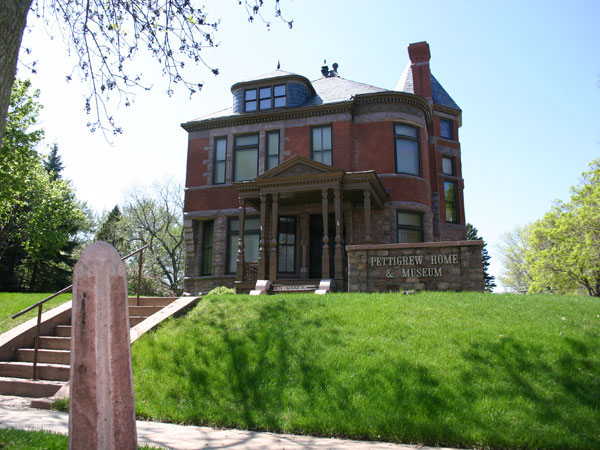Cathedral Historic District: Sioux Falls, South Dakota

Summary
Rising nearly 100 feet above the adjacent downtown, the Cathedral Historic District neighborhood offers panoramic views of downtown Sioux Falls and the Big Sioux River valley. A page out of time, setting the Cathedral District apart is its late-1800s historic integrity. Home to some of Sioux Falls's largest and most ornate houses, the Cathedral neighborhood was where the city's most prominent and powerful citizens displayed their prosperity, confidence, and sophistication by building palatial Victorian- and post-Victorian-era houses.
Designated Area
Bounded by West 4th and West 6th Streets to the north, West 10th Street to the south, North Spring Avenue to the east and North Summit and North Prairie Avenues to the west.

The Cathedral Historic District is home to some of Sioux Falls's largest and most ornate houses, including a large collection of palatial Victorian-era homes. Photo courtesy of Kathy Rustwick.
Planning Excellence
The neighborhood was where the city undertook one of its largest construction projects — the building of St. Joseph Cathedral. Costing $400,000 by the time of its completion in 1919, the iconic spires of the neighborhood's namesake can be seen from virtually anywhere in the city.
At the forefront of new trends, the neighborhood was served by one of the city's first streetcars. It was home to two early primary schools and became home to the city's first and finest guest quarters, the Cataract Hotel, when it was relocated from downtown. It also was the first area of Sioux Falls to incorporate locally mined quartzite into the streetscape, and it added trees, virtually nonexistent in the South Dakota prairie at the time, into the landscape.
Today, with the help of local planning efforts and state incentives, the neighborhood is rediscovering its historical roots. Large Victorian homes were converted into multi-unit rentals in the mid-20th century because of increased maintenance costs and the need for military housing for a nearby radio school and air bases. Now these homes are being restored to their original grandeur, bringing back what is generally considered to be the state's finest residential district.

The Cathedral District's history as a premier neighborhood for the city's most prominent and powerful citizens comes alive in the Pettigrew House and Museum. The Queen Anne building is filled with antiques from the early 1900s and showcases life in a bygone era. Photo courtesy of Kathy Rustwick.
Defining Characteristics, Features
Exemplary Architecture
- Early inhabitants used building materials and architectural styles to express material and cultural attainment; two homes built entirely of quartzite
- Queen Anne style dominates district (1880-1900). Other Victorian and Romantic period houses built before period architecture (early 20th century) becomes in vogue
- Palatial homes incorporate amenities such as towers, turrets, wraparound porches, and porticoes; interiors include curved, leaded, beveled, jeweled, and stained-glass windows; elaborately carved exotic woods used for bookcases, staircases, fireplaces
- Majestic St. Joseph Cathedral (1919) designed in Romanesque and French Renaissance styles by French architect Emmanuel Masqueray; now undergoing restoration
- First South Dakota district added to National Register of Historic Places (1974); 220 structures, nearly half built before 1900
Views and Ambiance
- Established on summit of hill; roughly 78 acres that encompasses 16 full and six half city blocks; striking views of Sioux Falls's downtown and Big Sioux River valley
- Prevalence of locally mined quartzite solidifies sense of place; stone used for residences, hitching posts, retaining walls, curbs, streets
- Twin spires of St. Joseph rise to height of 185 feet, dominating skyline and creating indelible image of Sioux Falls
- Cathedral district residents among first to bring trees to South Dakota prairie; today mature street trees line sidewalks
Link to the Past
- Neighborhood has long embraced activism; in 1900 the Peoples Party held its national convention there to select its second presidential candidate; 30 women formed Women's Alliance in 1901 to respond to a lack of restrooms, rest areas for women travelling city
- Historical markers tell of neighborhood's past, including establishment of Women's Alliance and convening of Peoples Party national convention
- Pettigrew House and Museum showcases life in bygone era; fully restored Queen Anne house (1889); architectural markers highlight history of other individual homes
- Fifteen transit stops and five bus routes within one block of neighborhood
- Area's Minnehaha Springs originally attracted Sioux Indians who considered the waters therapeutic to sick and infirm; later used to manufacture soda water, cider, mineral waters
- Cateract (meaning powerful falls) Hotel (1871) reputed to be finest in the region; popular meeting place regarded as center of town
- District has two, early educational facilities: North School (now called Hawthorne) originally a two-story, four-room brick building; school features award-winning architectural design (1985) and incorporates Minnehaha Springs building. Dominican Sisters open parochial grade school (1905); in 1926 present St. Joseph School designed
Planning, Historic Preservation
- Sioux Falls's first comprehensive plan (1950s), developed by Harland Bartholomew and Associates, acknowledged need to preserve and maintain neighborhoods
- City plans (1979, 1996, 2010) give increasing emphasis to neighborhood conservation
- City's historic preservation ordinance (1986) established guidelines, procedures to help protect historic character; Board of Historic Preservation advises elected officials
- Ad hoc neighborhood citizens committee regularly consults with planning office
- Eight-year state property tax moratorium exempts any increase in assessed value resulting from rehabilitation of historic buildings

Constructed in 1919, St. Joseph Cathedral is the neighborhood namesake. Its iconic twin-spires can be seen from virtually anywhere in Sioux Falls. Photo courtesy of Kathy Rustwick.


